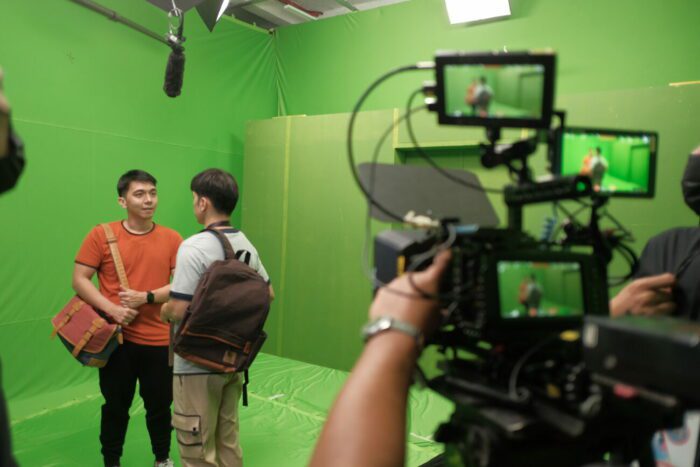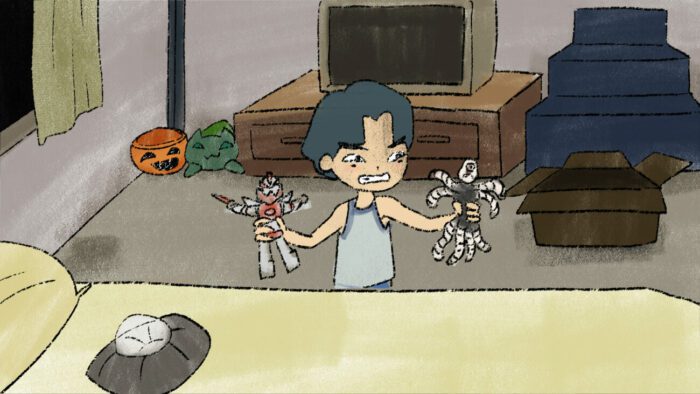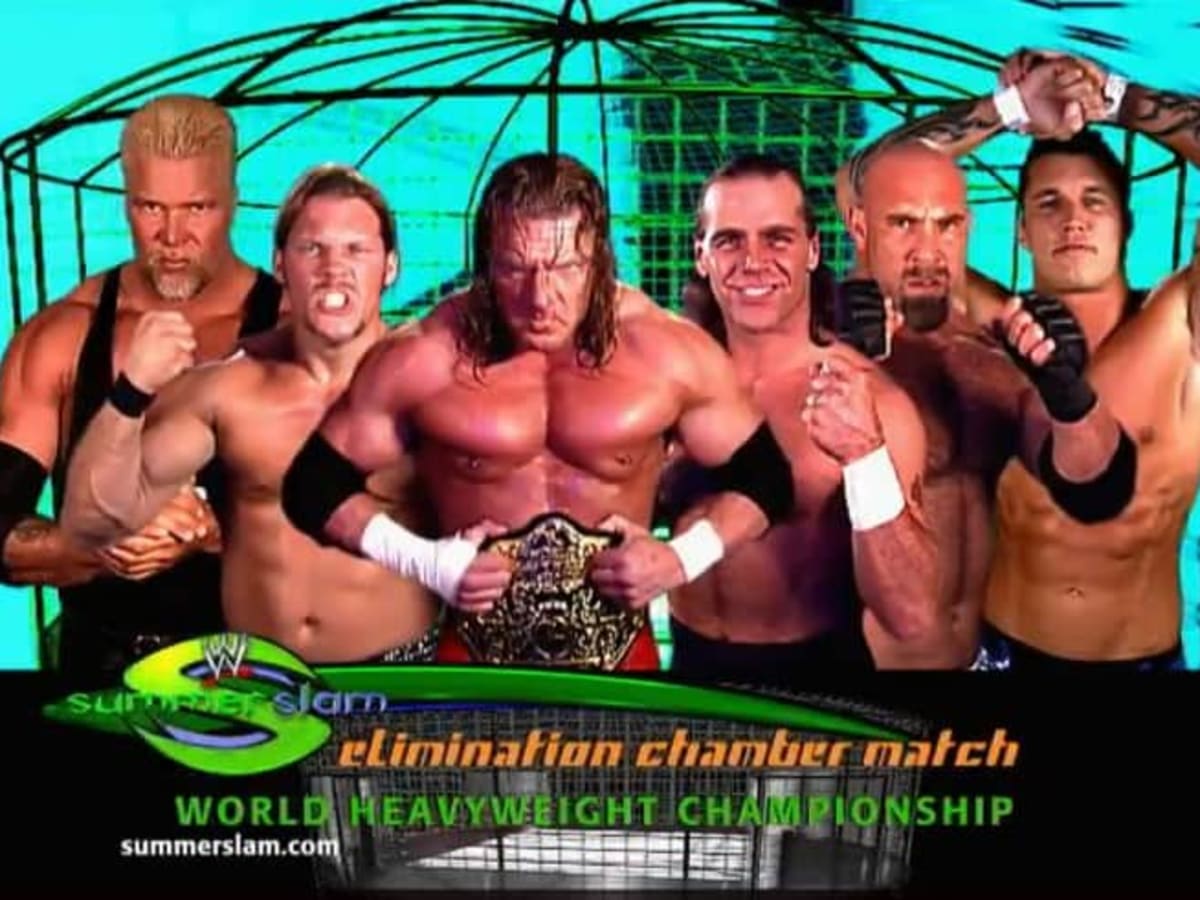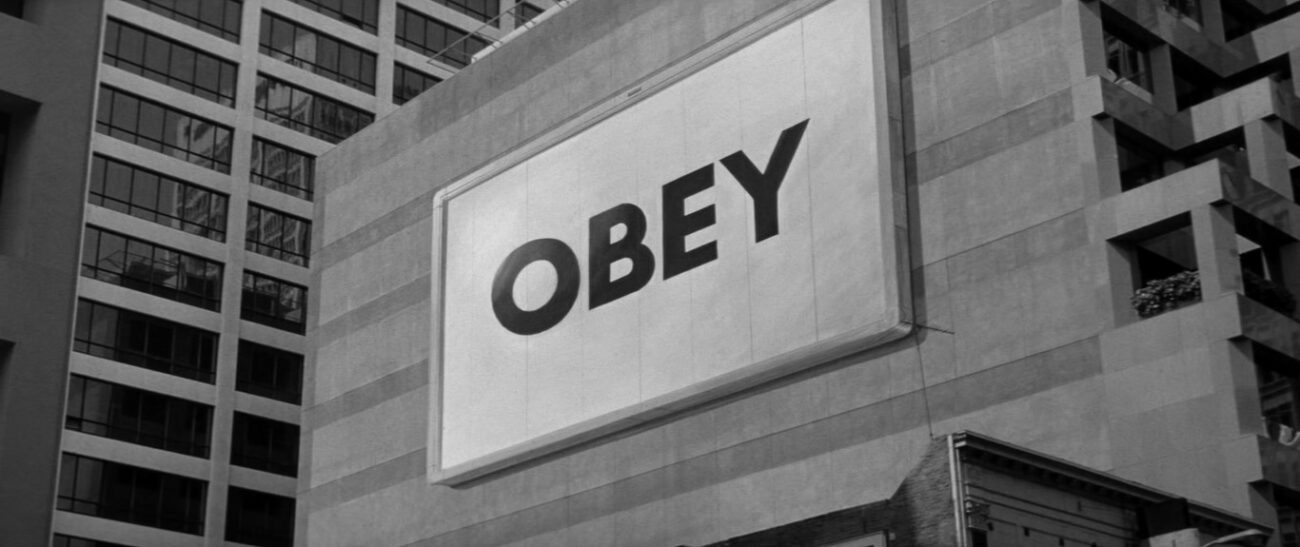Carl Joseph Papa’s film The Missing (or Iti Mapukpukaw) is an animated drama about a young man whose uncle has died; if I add that the young man has no mouth, and the story also involves an unfriendly alien, you’ll understand why this article features in our “Weird Cinema” department. I’ve been conducting interviews with filmmakers since September 2020, but this is the first time I’ve gotten to talk to someone whose film has a chance at an Oscar; specifically, the Philippines’ official submission for Best International Feature Film.
“I hope we get in,” said Carl.
I’ve read that he saw an open call for submissions and just went for it.
“We have this local festival in the Philippines,” Carl said, “where they finance ten feature films every year after competing with each other. It’s called Cinemalaya, and I’ve been submitting there for around ten years, and this is the only year that I’ve got in. Because it was the pandemic at the time, I thought ‘I have the material, I have it completely written down,’ so I submitted the project after their open call, and luckily we got in.”
The Missing is Carl’s fourth film, his third animated feature film. “The first was more experimental, sort of semi-autobiographical,” he said, “not like the others.”
Having brought up the animation, I asked Carl what prompted him to choose the rotoscope animation style, rather than live action.
“You could say that animation is my forte,” Carl said. “My short films are mostly animated. But this one, when I was writing it down, I knew it was going to be animation. Part of selecting rotoscope is because I want to capture that feel of confusion: when you see rotoscope, you question whether things are real or not, so that feeling of confusion is something that I can complement with the protagonist’s mental state. As the story progresses, there are a lot of things that are happening to him, and for him, he’s also questioning whether things are real or not. So, I think rotoscope perfectly captures that feeling.”
Carl had mentioned how the viewer doesn’t know what’s going on, and I hadn’t known what to expect, either, when I first read the film’s description: it might have been sci-fi, surreal, who knows! I asked whether this difficult-to-categorise description made The Missing difficult also to market or get funding.
“Well, if we are just going to base it on the log line or synopsis, it is a tough sell,” Carl agreed. “That’s why, whenever we get to meet with financiers or investors, I do my best to be available and be the one to pitch what the project is, what the story is about, what is the message of the film: it has to come from me, I have to explain it fully.”
My teenager had assumed The Missing was going to be miserable, when I gave her the description, and was surprised to hear me call it uplifting when I got to the end. I asked Carl how he went about finding an appropriate balance to the tone of the story when writing it.

“When I was writing it, I had this thing in mind that the film has to give hope to people,” Carl said. “I don’t want to hurt people who’ve been through the same thing as Eric, but rather help them and be caring towards the people who watch it. Because at the end of the day, the message of the film, which is to reclaim one’s voice, is very important; and if we were to end it very dark and lonely, it’s going to be very tough to watch, especially if you’ve gone through the same stuff as Eric. So, we had to find balance, showing the bad but also giving hope to people: there is a way, this is not the solution entirely, but it is a way to start recovery and urge you to speak.”
The Missing was beautifully drawn, metaphorically and literally; and there is a lot in the film about relationships; the sensitivity of people around Eric who gave him the understanding he needed. I dared to ask Carl whether that was his view of how people really behave in the Philippines, or whether it was wishful thinking.
“Part of it is wishful thinking,” Carl admitted, “but I did plenty of research, and I talked to a psychologist about people who have gone through trauma. One way to help them is for them to have a very solid and loving support system: that’s what I did with the characters of Carlo and Rosalinda, played by Gio Gahol and Dolly De Leon respectively. Both of them are really good listeners, and patient with Eric; they didn’t have the ability to understand what was going on with him, but they were able to let him find his time to speak up. I think that is important in the film.”
I hope they are just as understanding after he speaks up!
“In my head, they are,” said Carl, smiling.
As well as the characters, the cast themselves worked beautifully together. I asked Carl how he went about selecting his actors.
“When we were in pre-production,” he said, “we wrote down the actors who we thought would be complementary with each other, and Carlo [Aquino] who plays Eric is such an intense actor, and we needed to balance that out. We felt Gio Gahol and Dolly De Leon were the perfect balance for his intensity. Then what I did was I pitched the film to them, explained what it is about, what we’re trying to accomplish, so I think they fell in love with the material right there.”

It must be interesting for an actor presenting his feelings via his face when much of his face is not visible. I asked Carl what it was like to direct that.
“Actually, it was a struggle at the start,” Carl said, “but we had to make it work because it’s the goal of the film; to have the feeling that this person doesn’t want to talk. I think it’s harder for the co-actors to mingle with him, to speak to him: as actors, you have to draw from the environment and feed from each other, but luckily Carlo is a very impressive actor. Even if he’s not speaking, you can see he tries to with his eyes. That’s what Gio Gahol and Dolly De Leon worked with. We had to find our footing at the first day, and I tried to explain as much as I could, because we were only shooting on green screens, so we all had to use imagination. Like ‘now you’re inside a car’ or ‘now you’re inside a cinema’.”
Going back to the animation, I asked Carl what it was like to direct a rotoscope feature.
“I actually did the same style with my first film, so I’m quite familiar with it,” said Carl, “but I guess I did a lot of mistakes in Manang Biring and learned a lot from it, so we tried to avoid as much problems as we can when we made this one. It was hard work, because I did the compositing as well: when the animators had done their work, I had to put it all together. I have a bunch of really cool, very young group of people, and they were all game. Before they accepted to be animators of the film, I made sure they were a hundred percent on board with the message of the film, so that was the starting point with them. They all knew we had a tight deadline, but I think we did well managing our time and all of the ninety animators. It was a lot, yes, but mostly smooth sailing.”
Not all of it was rotoscope, mind you: there was a different style in the flashback sequences. I asked Carl how he chose what that style should be.
“For the flashbacks, I wanted it to feel like it’s a memory that’s stuck in childhood,” explained Carl. “I wanted to feel like it’s nostalgic and it looks like it’s drawn by a kid: that was the main reason why I selected that style.”
It really helps to go into this film without knowing too much, but going along with the main character’s gradual exploration, so I tried to tread carefully around the conversation to avoid spoilers. In contrast, I’m aware that Carl has been talking about some of his own history, in order to encourage others to speak. I asked him how he navigates that sensitively, without spoiling the mystery of The Missing.

“It’s tough,” he laughed. “I usually talk about it after people see the film.”
I wasn’t sure if that meant The Missing has already had a wide release in The Philippines.
“Not a wide release,” he said, “but we had a premiere in Cinemalaya in Manila, then a two-week run in microcinema, and trying to get more screenings in around next year.”
I hope to see it in a couple of film festivals in the UK; I really think it merits that exposure.
Teresa Barrozo’s score complemented the mood of the film, and I asked Carl how he briefed his composer.
“Teresa is my friend,” said Carl, “and we worked together on Paglisan, my second animated film. So, what I did was I actually sent her the script really early, before the post-production, and already told her about the story of the film. When she finally read it, we talked about it and what I expected the music to be. My main pointers or things I wanted her to do was complement the mood of the film. It has to start quite lively/funny because we wanted people to question themselves if they are laughing or something; we wanted to bring that feel at the start. As the story progresses, the music feels like part of the sound, it bleeds with the sound as well. Actually, there were parts of the film where you think it’s just sound effects, but actually, the fly sound and the breathing are actually part of the music. Teresa did it in parts; I told her the parts where I didn’t want music and we discussed that. It’s really me and her talking about the film constantly until we get it finished and then when she finished the score, we had to sit down with Lamberto Casas Jr., the sound designer, so that everything works together.”
Bringing the conversation back to the present, and the film’s submission for Oscar nomination; I asked Carl how he felt it might impact his career if it was indeed selected into the shortlist.
“Well, the thing is I make films whenever I have something in mind,” he said. “I don’t have to make anything if I don’t feel like it, or if I don’t have a story in mind. That’s why the time difference before my last film and this one is so far apart. I have a day job; I’m a software engineer. So, I try to not get fired there as well. Maybe wishful thinking if ever I get to make another film with the Oscar buzz that we are having with this submission: hopefully we could get more investors, with maybe a bigger budget for the next film we make. So, here’s hoping we get that.”
So, does Carl not have any plans right now?
“Yes, I am writing a story right now,” he reassured me, “but it’s still brewing in my head.”
I’d certainly love to see anything else Carl makes…and best of luck for the Oscar!




